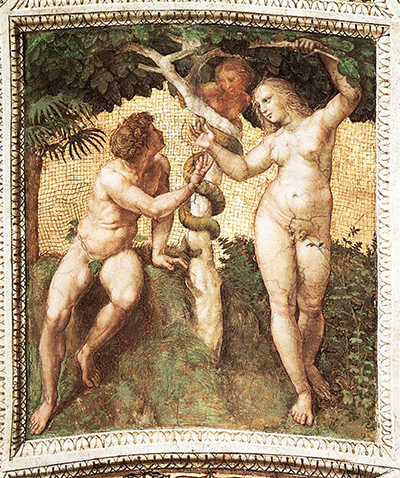Adam and Eve is a section from the Raphael Rooms in the Palace of the Vatican. It was painted in the 16th century by Raffaello Sanzio and covers the ceiling in one of the apartments.
It shows a Biblical scene from the Book of Genesis: Adam, Eve, and their temptation in the Garden of Eden. Although Raphael is noted for his work in oils, the Raphael rooms are decorated in fresco, where paint is worked into damp plaster. The background of the scene also includes sections of gilding, where gold leaf is applied to the plaster.
The Raphael Rooms are a quartet of rooms in the papal apartments in the Palace of the Vatican. In 1508 or 1509 the artist Raffaello Sanzio da Urbino (along with this studio) was commissioned to provide fresco decorations for these rooms, which at the time were to be a suite of apartments for Pope Julius II.
The Stanza della Segnatura or "Room of the Signatura" (referring to the Signatura of grace, the tribunal which was once house here) was the first of the rooms to be decorated. The ceiling depicts Adam and Eve along with the serpent in the Garden of Eden as they are tempted to consume the forbidden fruit. This is the Fall of Man, a Biblical scene in keeping with the room's overarching themes of judgement, wisdom and spiritual guidance.
This piece and the other frescoes are of great artistic and historic significance Together with Michelangelo's work on the Sistine Chapel, the frescoes in the Raphael Rooms mark the High Renaissance in Italy (or more specifically in Rome). Raphael's depiction of Adam and Eve shows influences from earlier works, including those of Michelangelo - Eve's pose in particular is strikingly reminiscent of Michelangelo's Leda and the Swan, where Leda is shown in just such a contrapposto pose. Raphael is known to have seen this work and to have made drawings of it prior to his creation of the Adam and Eve fresco.
The Fall of Man has been a popular subject throughout much of Western artistic history. This depiction can usefully be compared to Michelangelo's later and perhaps more ambitious version on the ceiling of the Sistine Chapel, which depicts the temptation of Adam and Eve alongside the expulsion from the Garden. This was an unusual choice since the Temptation and Expulsion were typically depicted separately.
Like many depictions both before and after Raphael, both versions include a serpent with a human torso, face and arms but a snake-like lower body. This was very common; in many depictions the human half of the serpent is female, as in the Raphael version here. (This association between femininity was widespread at that time in history.) Some even earlier versions add wings, horns and even feathers to the Biblical serpent; in Raphael's work, though, we only see a human-reptile hybrid.




